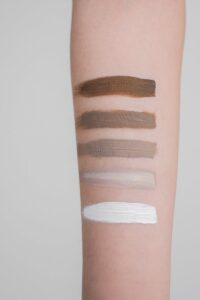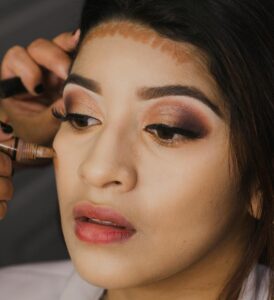How to Find Your Undertone for the Perfect Foundation Match
Finding the perfect foundation match can be a daunting task, but the understanding to find your undertone is the key to achieving a flawless makeup look. Your skin tone is just part of the equation; the undertones beneath the surface of your skin play a crucial role in determining which foundation shade will enhance your natural beauty. In this guide, we will explore the intricacies of skin undertones and how they relate to choosing the right foundation for your complexion.

Photo by Johnny Rodriguez on Unsplash
Understanding Undertones
Undertones are subtle hues that exist beneath the surface of your skin, and they significantly influence your overall skin color. While skin tone can change due to sun exposure or other factors, undertones remain relatively consistent throughout your life. To find your perfect foundation match, it is essential to understand your skin undertones. Identifying whether you have warm, cool, or neutral undertones will enable you to choose a foundation that complements your complexion, providing a flawless finish that flatters your natural beauty.
What Are Skin Undertones?
Skin undertones refer to the underlying hues that affect the overall color of your skin. They can be categorized into three main types: warm, cool, and neutral. Warm undertones typically exhibit a golden or peachy hue, while cool undertones lean towards pink or blue. Neutral undertones are a blend of both warm and cool, making them versatile for a variety of foundation shades. To determine your undertone, you can examine the color of your veins; greenish veins suggest warm undertones, bluish veins indicate cool undertones, and a mix of both hints at a neutral undertone.
The Importance of Undertones in Foundation Matching
Choosing the right foundation shade goes beyond simply matching your skin color; it involves understanding how your undertones interact with different shades. A perfect match can enhance your complexion and create a seamless look, while selecting the wrong foundation can lead to a washed-out appearance or an overly contrasting makeup look. Makeup artists emphasize the importance of knowing your skin tone and undertone, as this knowledge allows you to find the best foundation that complements your unique features and achieves a flawless finish.
Types of Undertones: Cool, Warm, and Neutral
When it comes to skin undertones, identifying whether you have cool, warm, or neutral tones is essential for selecting the right foundation. Cool undertones often suit foundations with pink, red, or blue hues, while warm undertones are best complemented by foundations with golden or yellow shades. Those with neutral undertones have the flexibility to experiment with both warm and cool foundations, making the process of finding the right shade even more enjoyable. Understanding these categories will empower you to confidently choose a foundation that not only matches your skin tone but also brings out your natural beauty.
How to Find Your Undertone

Photo by Jeff Siepman on Unsplash
Identifying your undertone is a crucial step in the process of finding the perfect foundation match. There are several simple tests you can perform at home to help determine your undertone, which will ultimately guide you in choosing the right foundation shade. By understanding your skin undertone, whether it be warm, cool, or neutral, you can more easily find the best foundation that enhances your natural beauty. These tests not only provide clarity on your skin type but also ensure that your makeup look is flawless and well-coordinated with your overall complexion.
Simple Tests to Determine Your Undertone
To find your undertone, you can start with a few straightforward tests. One popular method is the white paper test, where you hold a piece of white paper next to your face. If your skin appears more yellow or golden against the white, you likely have warm undertones. Conversely, if your skin looks pink or rosy, you may have cool undertones. Another effective way to determine your undertones is by examining the color of your veins. If your veins appear green, it suggests warm undertones, while bluish veins indicate cool undertones. These simple tests can guide you in finding the right foundation that matches your unique skin tone and undertone.
Analyzing Your Skin Tone and Its Impact
Your skin tone significantly impacts your overall appearance and the type of foundation shade that will flatter you best. It’s important to analyze your skin type—whether it’s oily, dry, or combination—alongside your undertone. For example, individuals with oily skin may prefer matte foundations that control shine, while those with dry skin may benefit from hydrating formulas that provide a dewy finish. By understanding how your skin tone and undertone interact with different foundation textures and formulations, you can make informed choices that enhance your complexion and result in a flawless makeup look.
Identifying Your Undertone Through Vein Color
Vein color is a reliable indicator for identifying your undertone and plays an integral role in finding the perfect foundation match. To analyze your veins, check the underside of your wrist in natural light. If your veins appear green, you likely have warm undertones, which are best complemented by foundations with yellow or golden hues. If your veins are more blue or purple, you probably have cool undertones, making pink or red-based foundation shades ideal for your complexion. A combination of both colors may indicate neutral undertones, allowing you the versatility to choose from both warm and cool foundation shades. This insight is invaluable for anyone looking to find their perfect foundation.
Finding the Right Foundation Shade

Photo by Monstera Production on Pexels
How to Match Foundation to Your Undertone
To achieve a perfect foundation match, it is essential to consider your undertones alongside your skin color. When you match foundation to your undertone, you create a harmonious blend that enhances your natural beauty. Warm undertones often pair well with golden or peachy foundation shades, while cool undertones shine with pink or blue hues. Neutral undertones can enjoy the flexibility of both warm and cool shades. Understanding your skin undertone will empower you to choose the right foundation shade that flatters your complexion, leading to a flawless makeup look.
Testing Foundation Shades on Your Skin
Testing various foundation shades directly on your skin is a crucial step in finding the right foundation for your complexion. Begin by applying a few foundation swatches on your jawline, blending them into your skin. Observe how each shade interacts with your skin tone and undertone in natural light. The ideal foundation shade should seamlessly blend into your skin, making it difficult to distinguish where the foundation ends and your skin begins. This method allows you to visualize how different shades can enhance your natural beauty, ensuring you find your perfect foundation match.
Tips for Selecting the Perfect Foundation
When selecting the perfect foundation, it is vital to consider your skin type, undertone, and desired finish. For oily skin, look for matte foundations that help control shine, whereas dry skin may benefit from hydrating formulas that provide a dewy glow. Additionally, always test foundation shades in natural lighting to accurately assess how they complement your complexion. Don’t hesitate to seek advice from makeup artists, as their expertise can guide you in choosing the right foundation shade and formula for your unique needs and preferences.

Photo by Laura Garcia on Pexels
Guide to Flawless Foundation Application
Preparing Your Skin for Foundation
Preparing your skin for foundation application is a vital step in achieving a flawless makeup look. Start by cleansing your face to remove any impurities and excess oils. Following this, apply a suitable moisturizer based on your skin type—whether you have oily, dry, or combination skin—to create a smooth canvas for your foundation. Consider using a primer tailored to your skin undertone, as it can enhance the longevity and appearance of your foundation. Proper preparation not only improves the application of your foundation but also ensures a seamless finish that flatters your natural beauty.
Application Techniques for a Flawless Finish
Mastering application techniques can significantly improve the appearance of your foundation and help you achieve a flawless finish. Using tools such as brushes, sponges, or your fingertips, apply the foundation in thin layers to build coverage gradually. Focus on blending the foundation into your skin seamlessly, paying attention to areas such as the jawline and hairline. For a more airbrushed look, consider using a damp makeup sponge to press and blend the foundation into your complexion. Proper application techniques will ensure that your foundation matches your skin undertone perfectly, enhancing your overall makeup look.
Adjusting Your Foundation for Different Skin Types
Different skin types require unique approaches when it comes to foundation application. If you have oily skin, opt for oil-free foundations and set your makeup with a translucent powder to reduce shine. For those with dry skin, choose hydrating foundations that help retain moisture, ensuring your makeup appears dewy and fresh. Combination skin may benefit from a mix of these techniques, applying matte foundation to oil-prone areas while using creamier formulas on dry patches. By understanding your skin type and adjusting your foundation accordingly, you can achieve the best foundation match that enhances your natural beauty.
What is an undertone and why is it important for finding the perfect foundation match?
An undertone is the subtle hue that lies beneath the surface of your skin and affects how your skin tone appears. Understanding your skin undertone is crucial for selecting the right foundation shade because it helps create a harmonious look that enhances your natural beauty. Without knowing your undertones, you might end up with a foundation shade that clashes with your complexion, leading to a less flattering makeup look.
How can I find my undertone?
To find your undertone, start by examining your skin color in natural light. One popular method is the vein test: look at the veins on your wrist. If they appear blue or purple, you likely have a cool undertone. If they look green, you probably have a warm undertone. If it’s hard to determine whether they’re blue or green, you may have neutral undertones! This method is a simple yet effective way to begin understanding your skin tone and undertone.
What are the different types of undertones?
There are three main types of undertones: warm undertones, cool undertones, and neutral undertones. Warm undertones often have hints of yellow, peach, or golden hues, while cool undertones may display pink, red, or blue tones. Neutral undertones are a blend of both warm and cool tones, which can make it easier to choose a foundation shade that complements your complexion. Knowing which type you fall into will guide you in selecting the best foundation.
How do I know my skin type affects the choice of foundation?
Your skin type plays a significant role in determining the right foundation for you. For instance, if you have oily skin, you might prefer a matte foundation that controls shine, while those with dry skin may opt for a hydrating, dewy finish. Understanding your skin type is essential when selecting a foundation, as it directly influences the product’s performance and longevity on your skin.
If you have combination skin, which features both oily and dry areas, you may need a foundation that balances both properties—perhaps a semi-matte formula that hydrates without adding excess shine. On the other hand, sensitive skin types should look for foundations that are hypoallergenic and free from harsh chemicals to prevent irritation.
Additionally, knowing your skin type can help you identify the right undertone for your foundation. If you have warm undertones, foundations with a yellow or golden base will complement your skin better, while cool undertones may look best with pink or blue-based foundations. Neutral undertones can often wear a wider range of shades.
Testing the foundation on your jawline or wrist in natural light can also help ensure a perfect match. Remember, skin can change with seasons, hormones, and aging, so it’s a good idea to reassess your skin type regularly. By understanding your skin type and its unique needs, you can choose a foundation that enhances your natural beauty rather than masking it.

